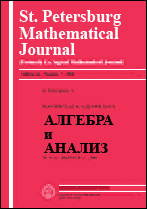|
This article is cited in 5 scientific papers (total in 5 papers)
Research Papers
Deviation theorems for solutions of linear ordinary differential equations and applications to parallel complexity of sigmoids
D. Yu. Grigorievab
a On leave from Mathematical Institute, St. Petersburg, RUSSIA
b Departments of Computer Science and Mathematics, Penn State University, State College, PA, USA
Abstract:
By a sigmoid of depth $d$ we mean a computational circuit with $d$ layers in which rational operations are admitted at each layer, and to jump to the next layer the substitution of a function computed at the previous layer in an arbitrary real solution of a linear ordinary differential equation with polynomial coefficients is admitted. Sigmoids arise as a computational model for neural networks. We prove the deviation theorem stating that for a (real) function $f$, $f\not\equiv 0$, computed by a sigmoid of depth (or parallel complexity) $d$ there exists $c>0$ and an integer $n$ such that the inequalities. $(\exp(\dots(\exp(c|x|^n))\dots))^{-1}\leq|f(x)|\leq\exp(\dots(\exp(c|x|^n))\dots)$ hold everywhere on the real line except for a set of finite
measure, where the iteration of the exponential function is taken $d$ times. One can treat the
deviation theorem as an analog of the Liouville theorem (on the bound for the difference of algebraic numbers) for solutions of ordinary differential equations. Also we estimate the number of zeros of $f$ in an interval.
Keywords:
Sigmoid, parallel complexity, deviation theorems, bounds for Wronskian.
Received: 13.04.1993
Citation:
D. Yu. Grigoriev, “Deviation theorems for solutions of linear ordinary differential equations and applications to parallel complexity of sigmoids”, Algebra i Analiz, 6:1 (1994), 110–126; St. Petersburg Math. J., 6:1 (1995), 89–106
Linking options:
https://www.mathnet.ru/eng/aa426 https://www.mathnet.ru/eng/aa/v6/i1/p110
|


| Statistics & downloads: |
| Abstract page: | 273 | | Full-text PDF : | 120 | | References: | 1 | | First page: | 1 |
|





 Contact us:
Contact us: Terms of Use
Terms of Use
 Registration to the website
Registration to the website Logotypes
Logotypes








 Citation in format
Citation in format 
